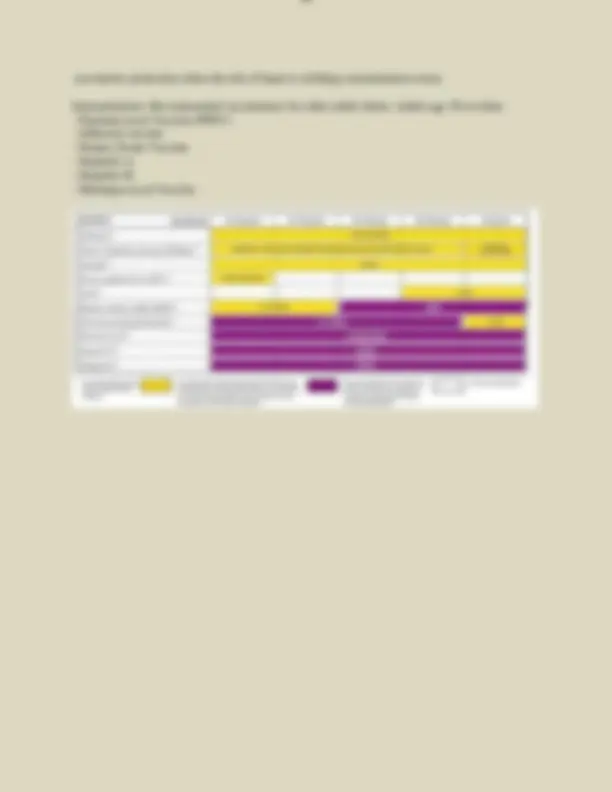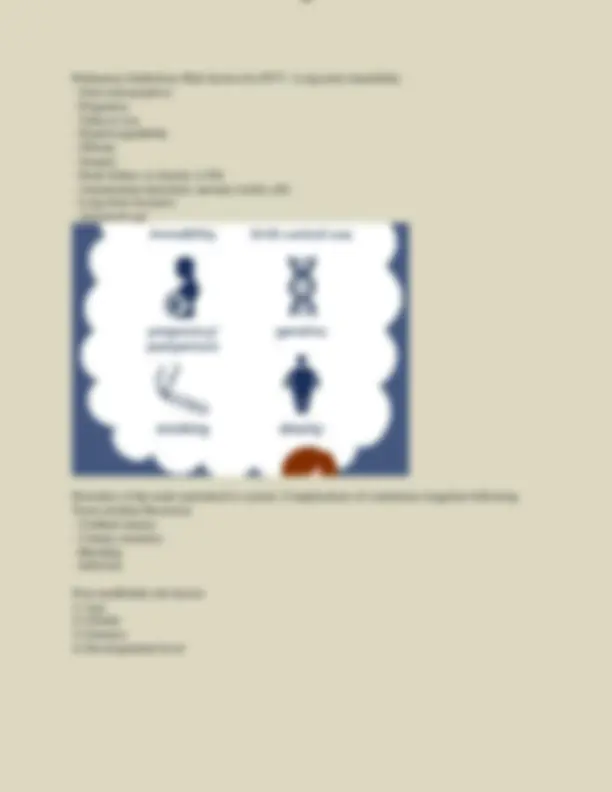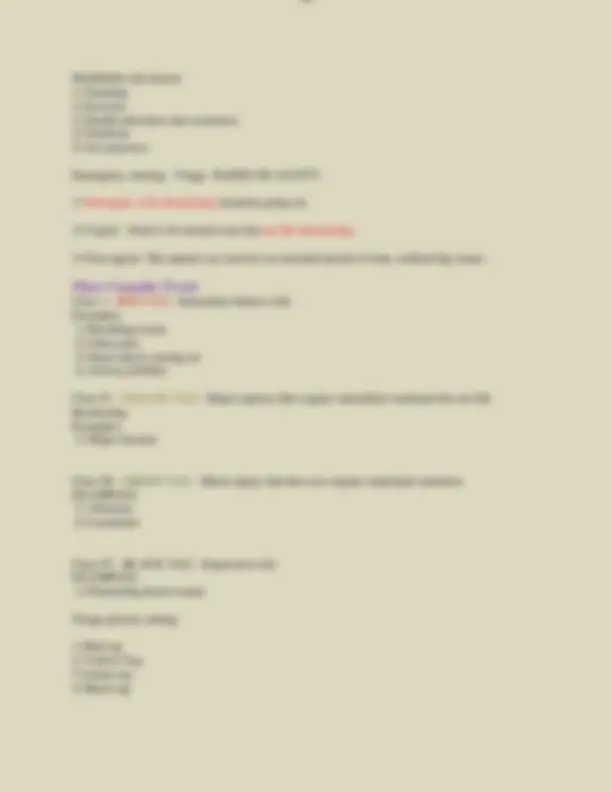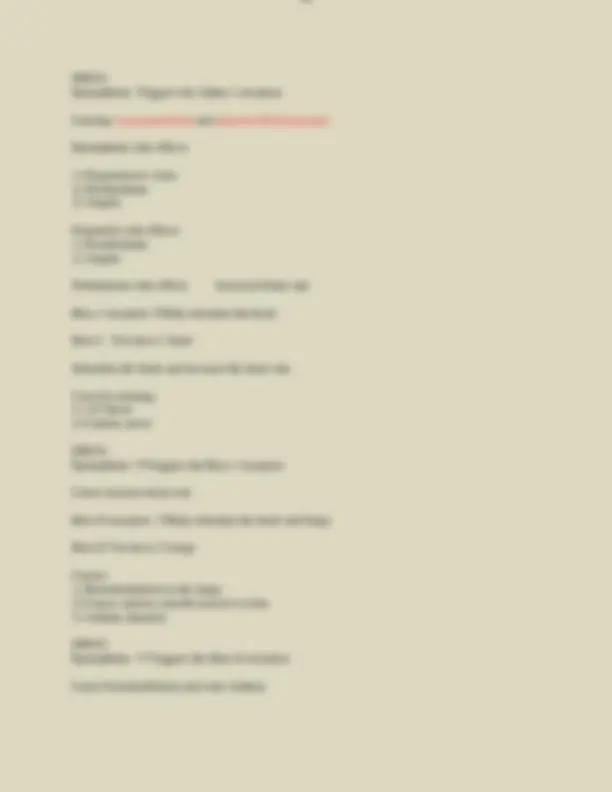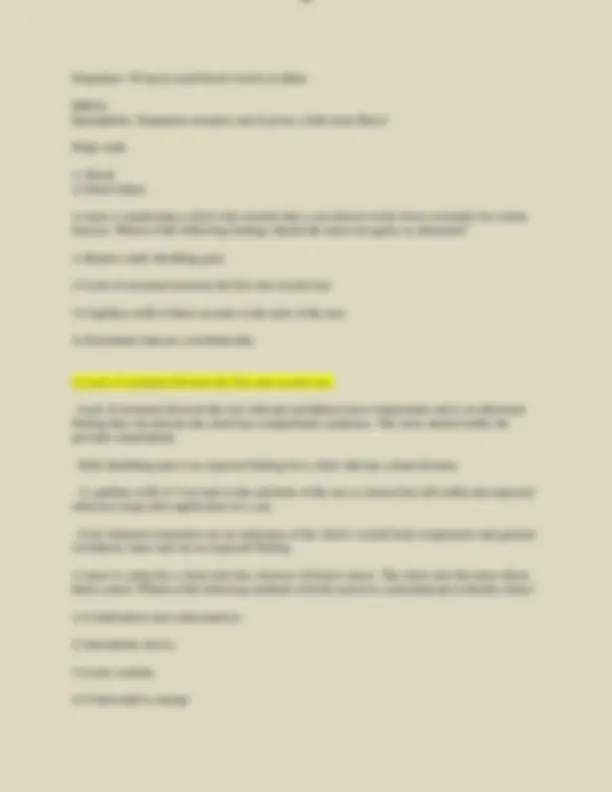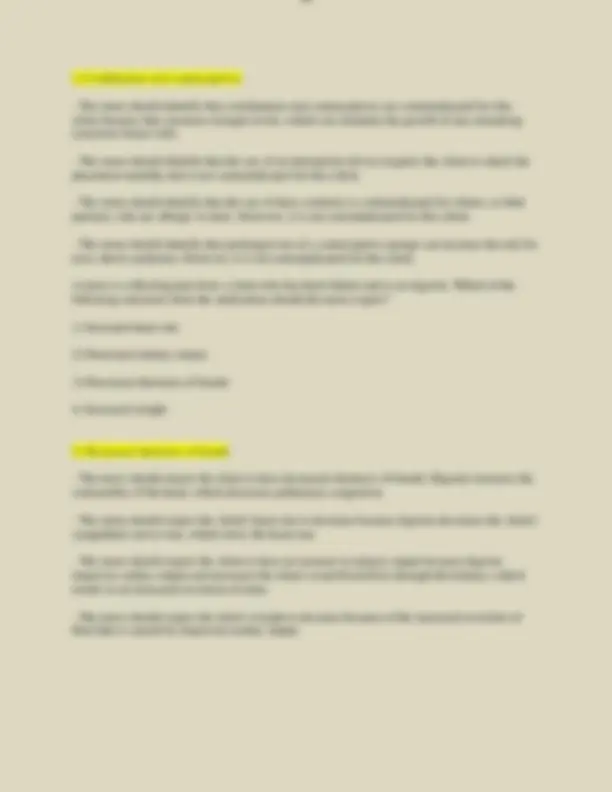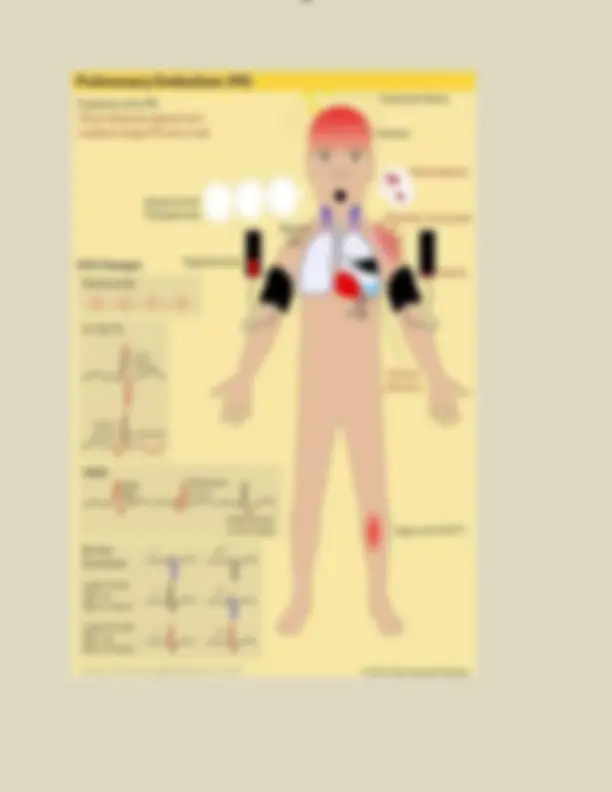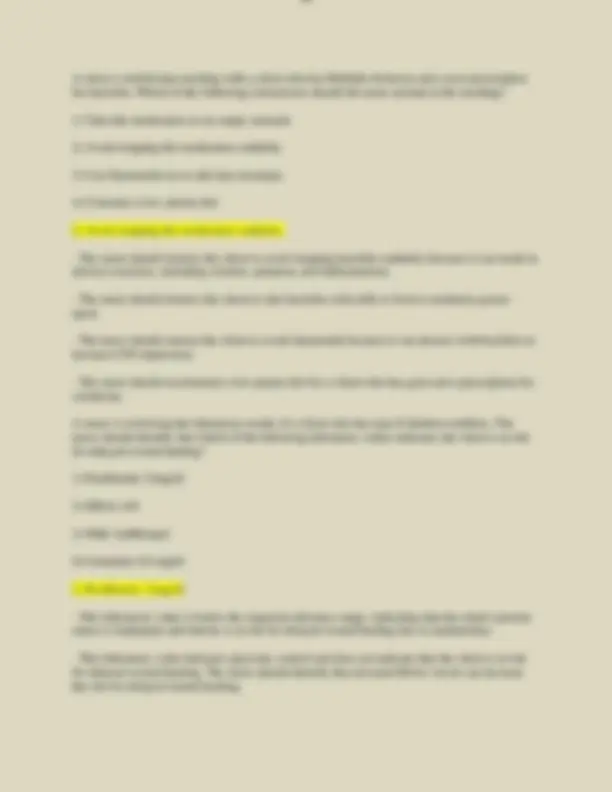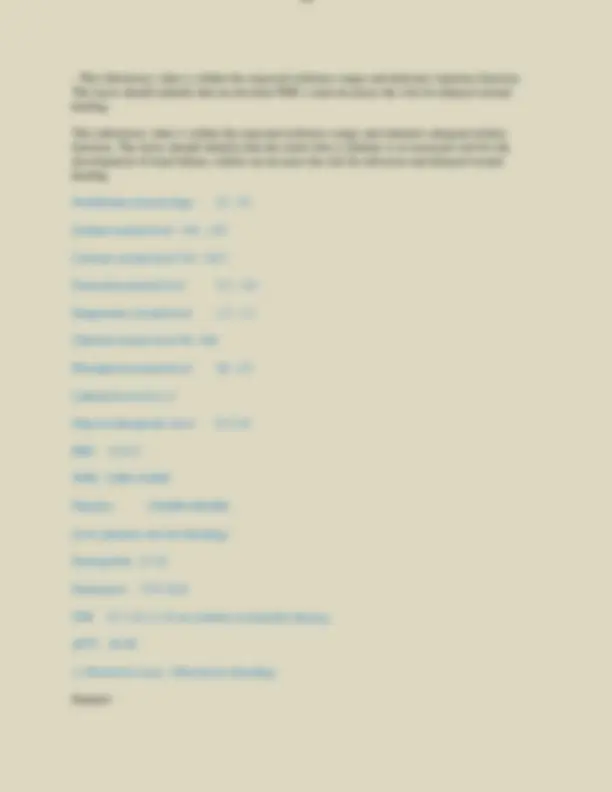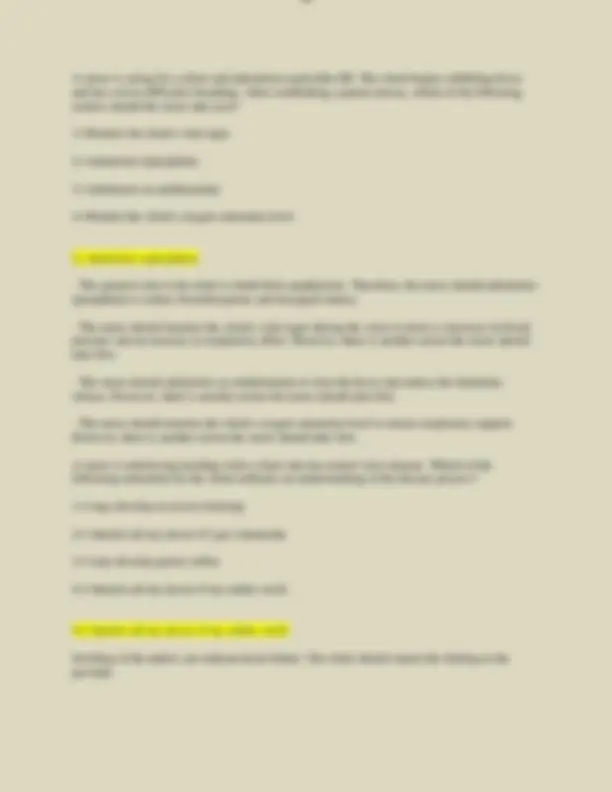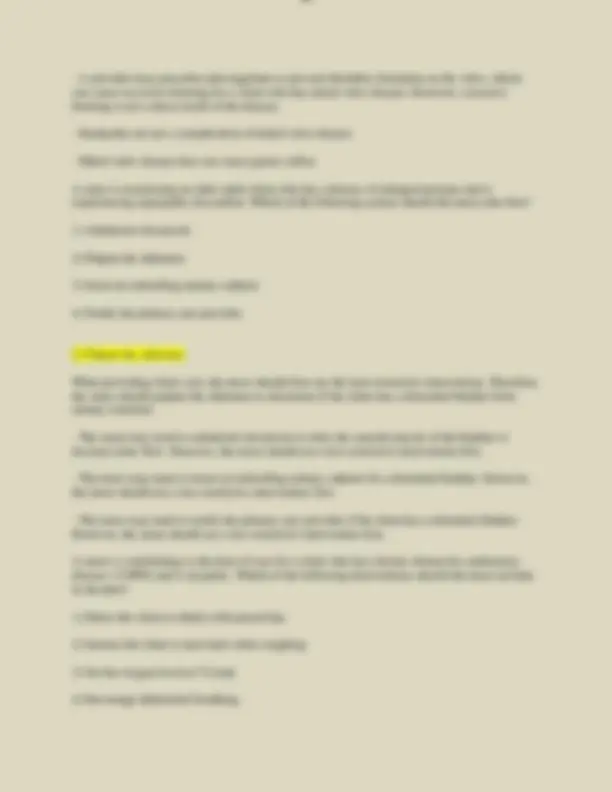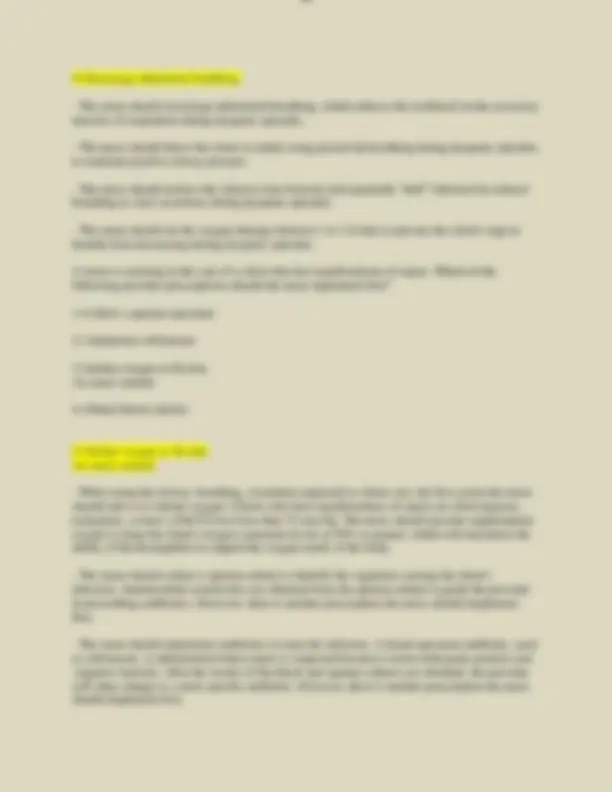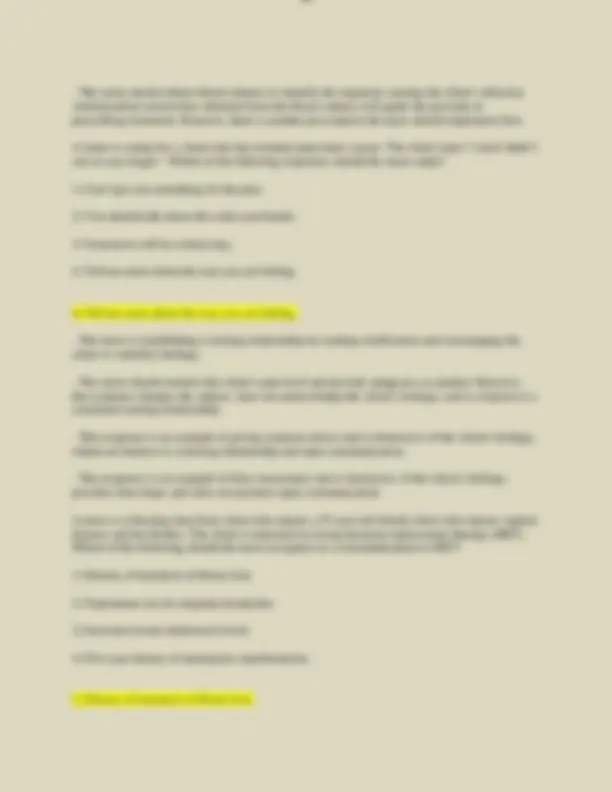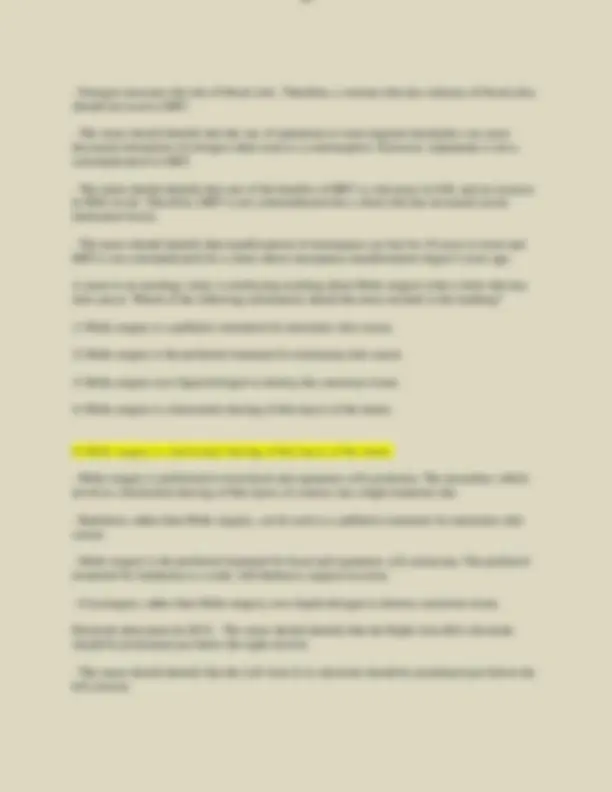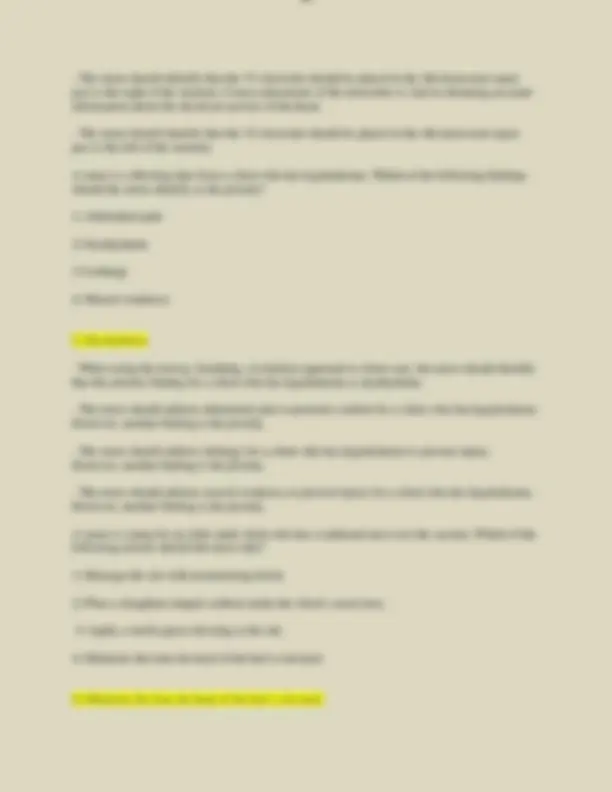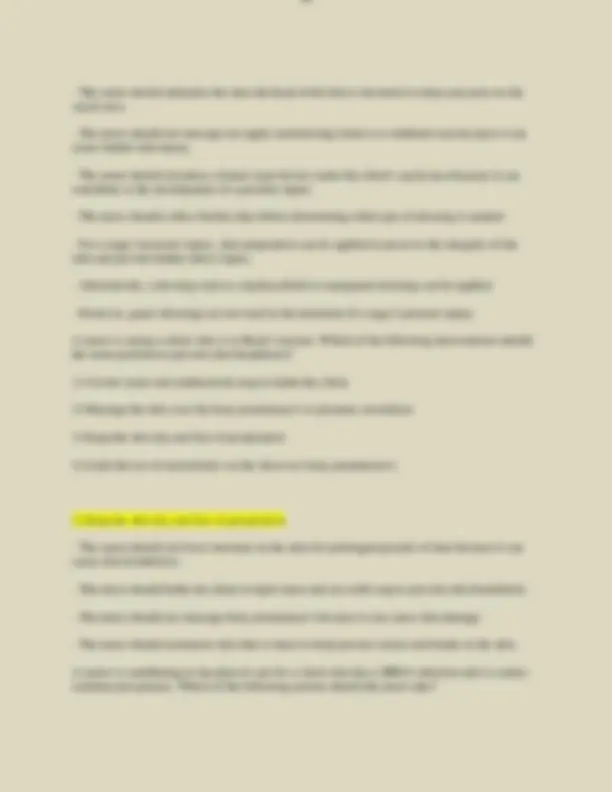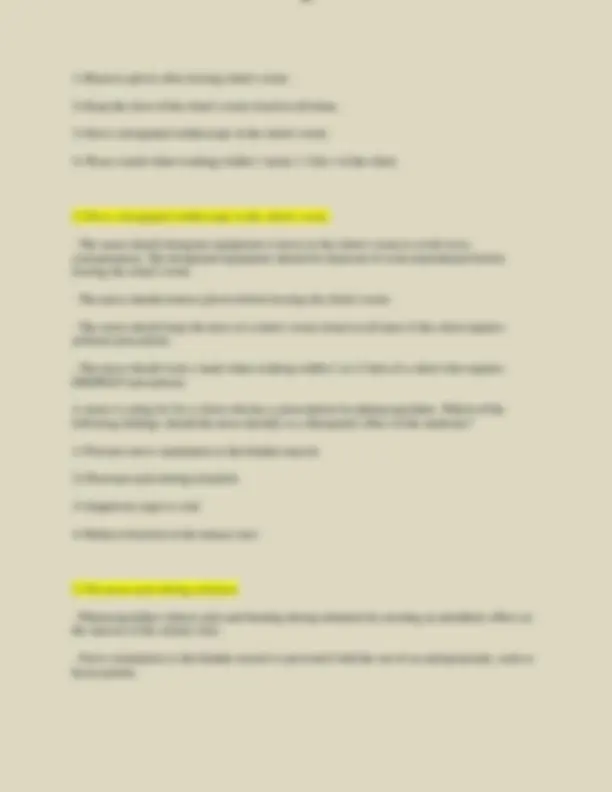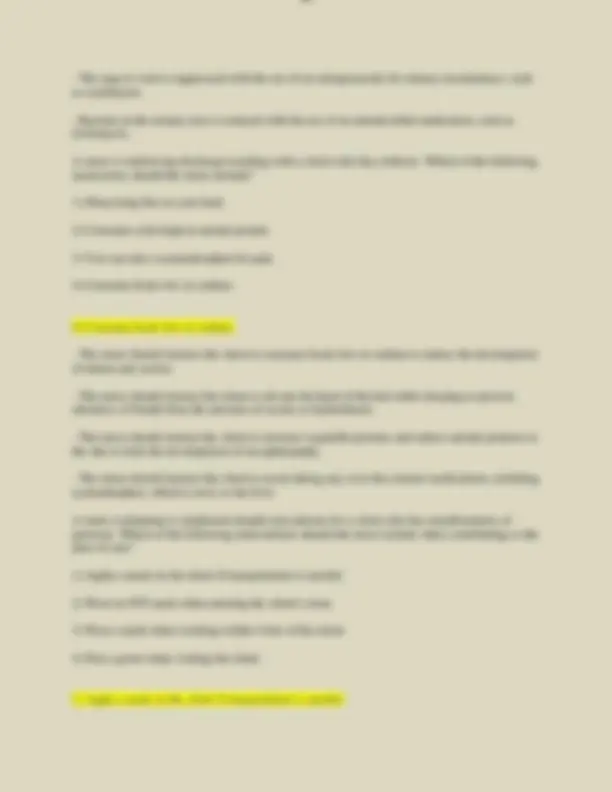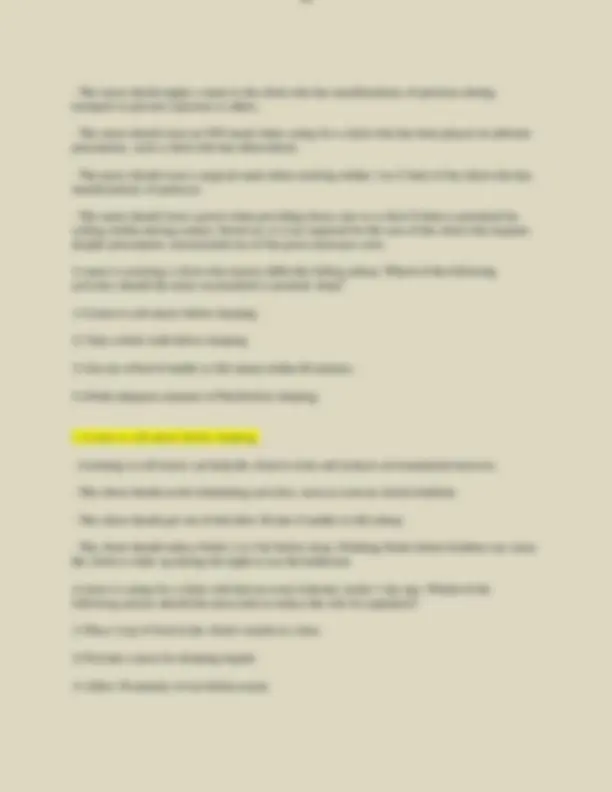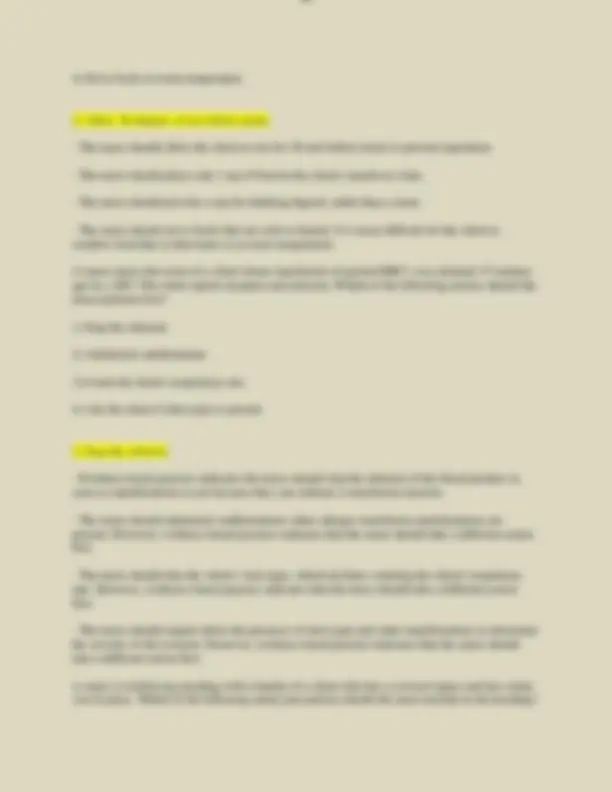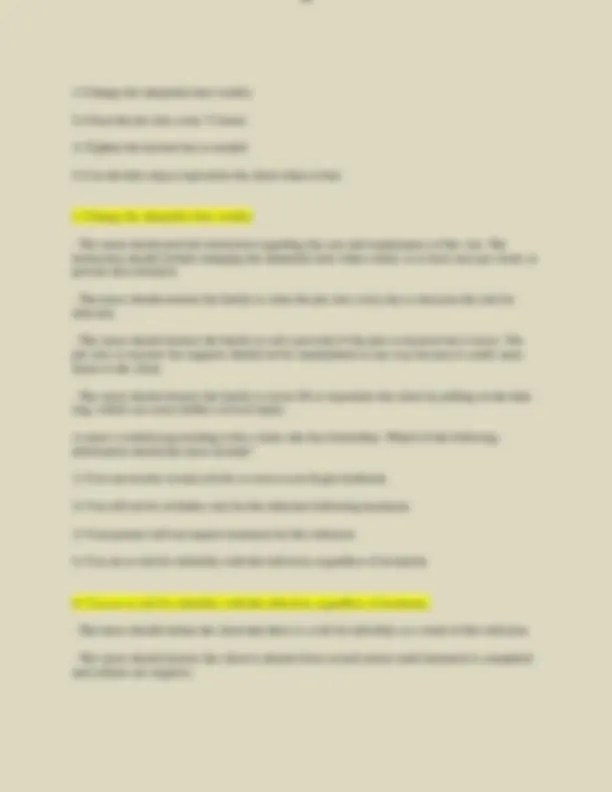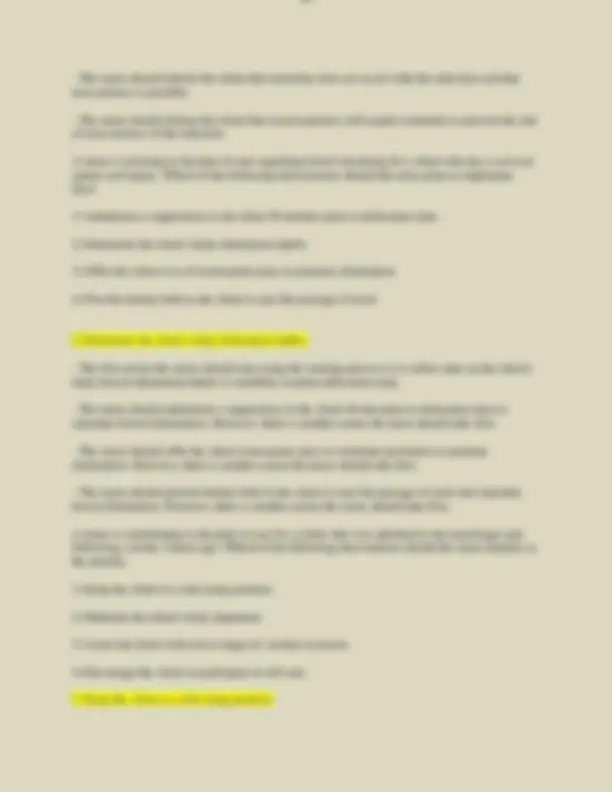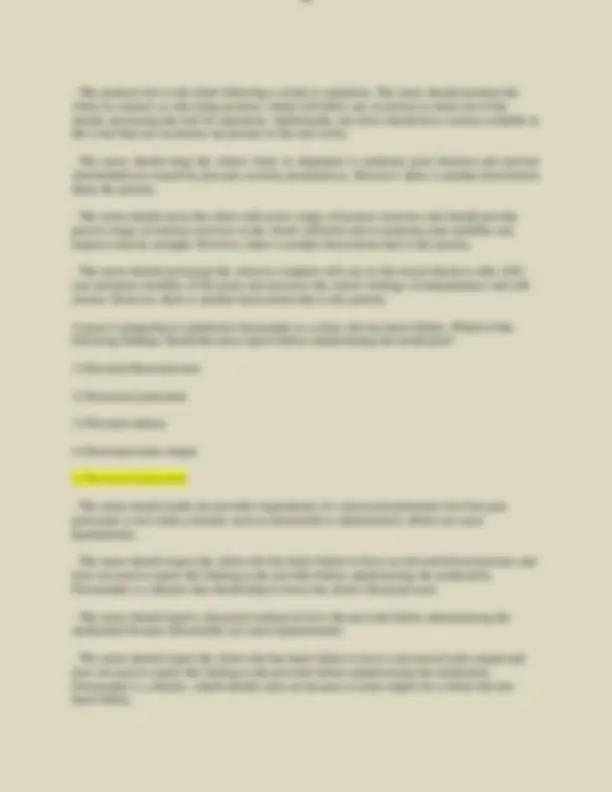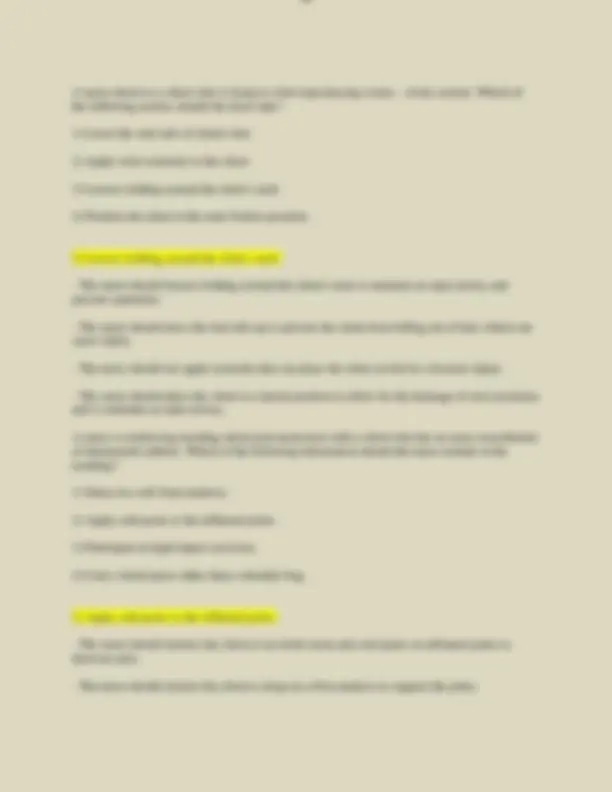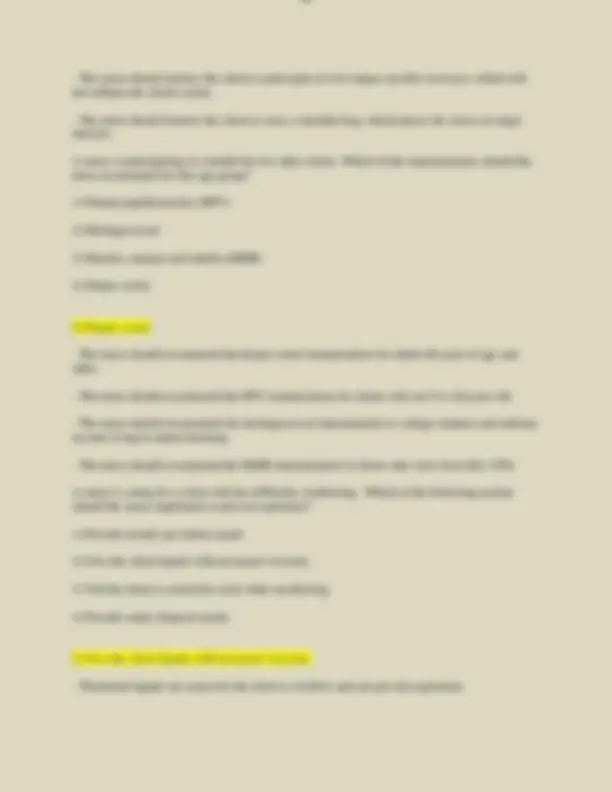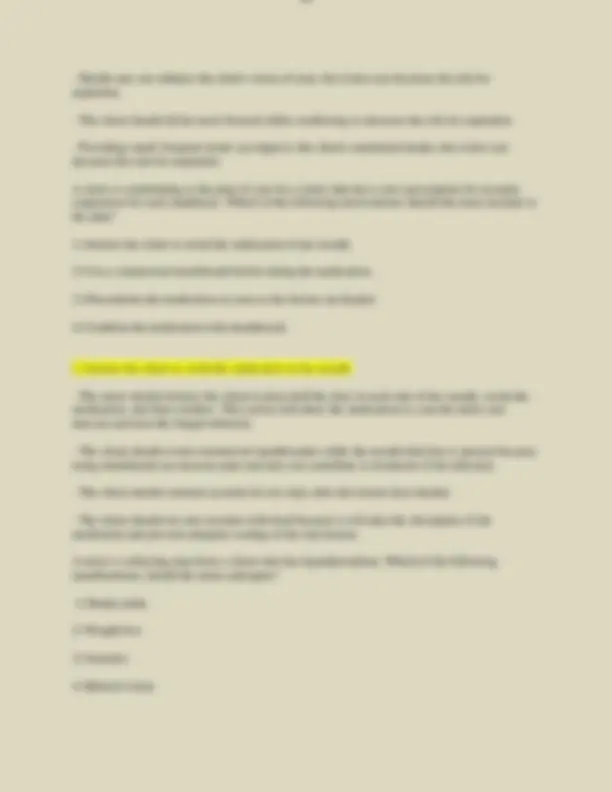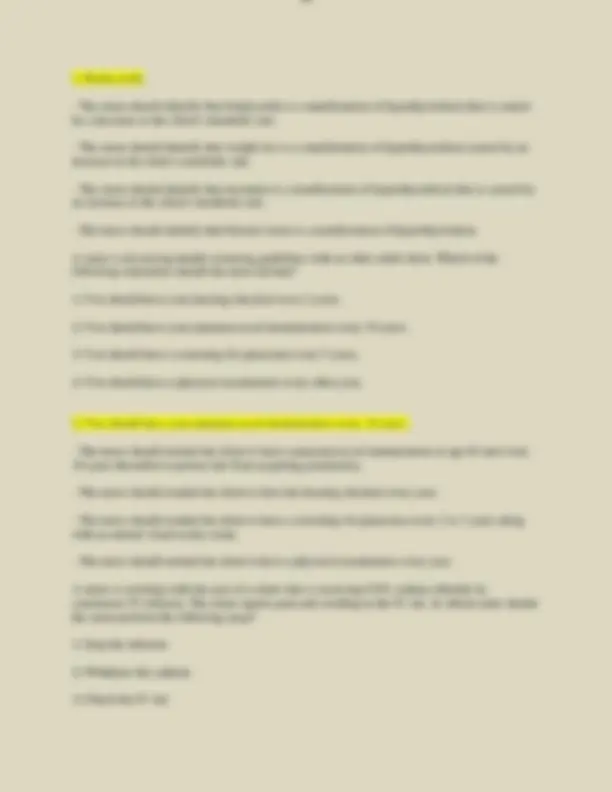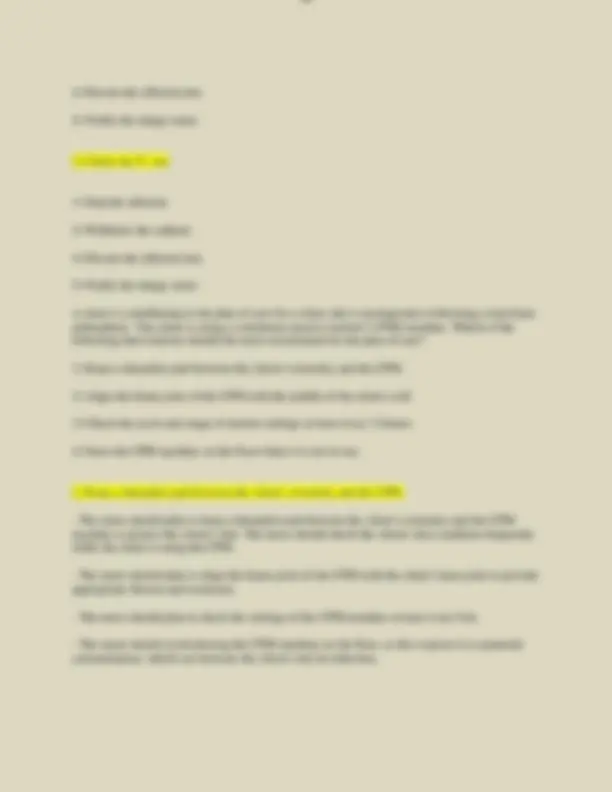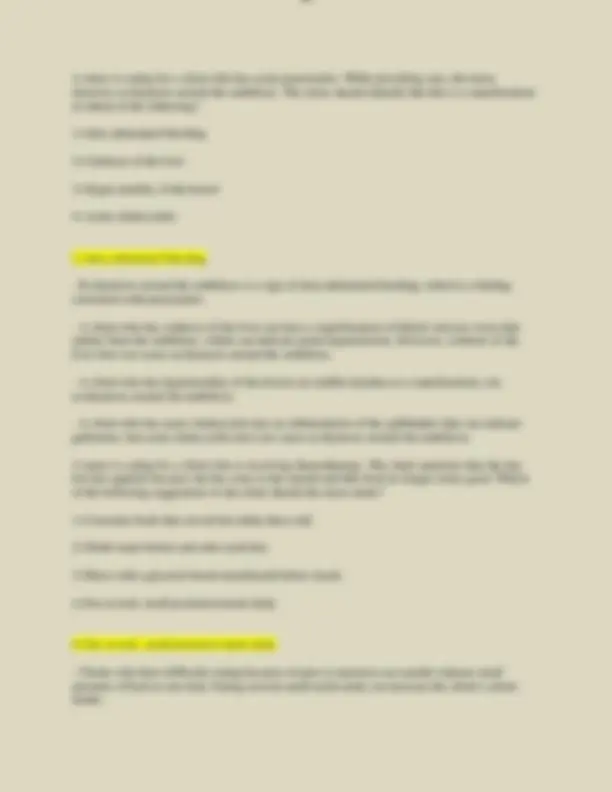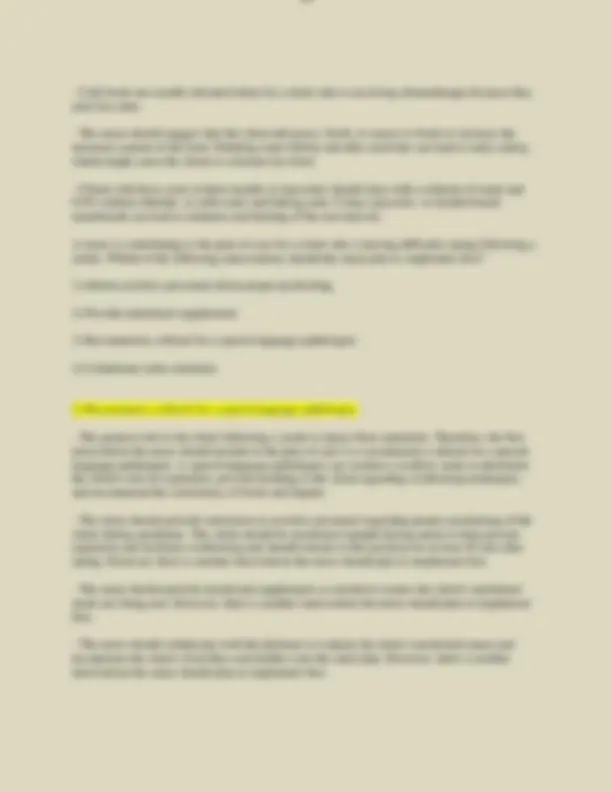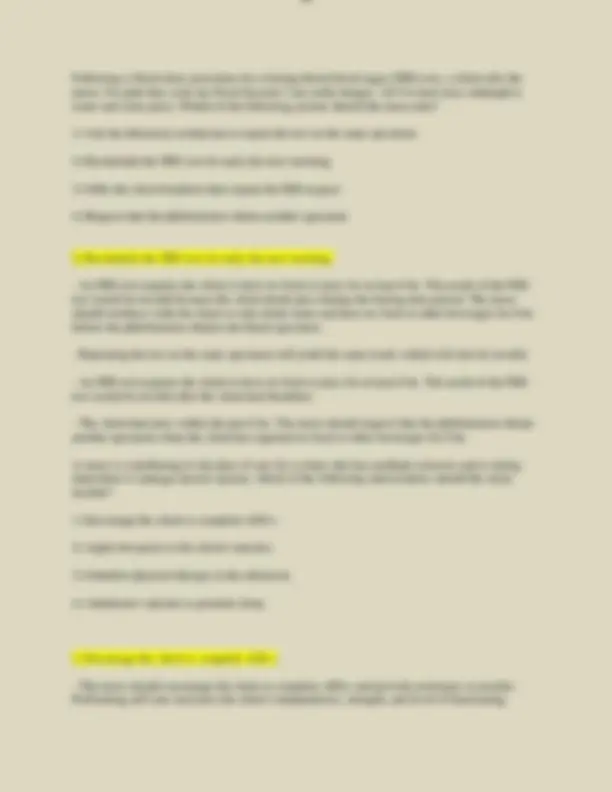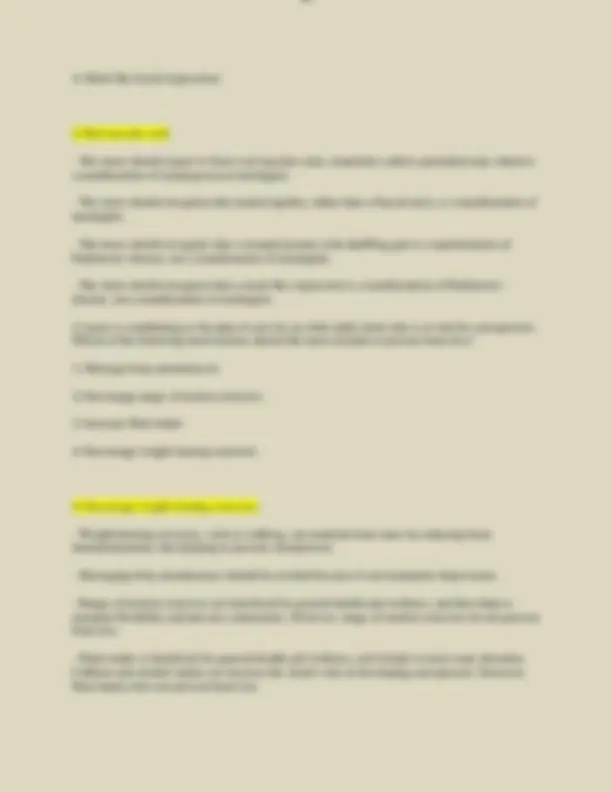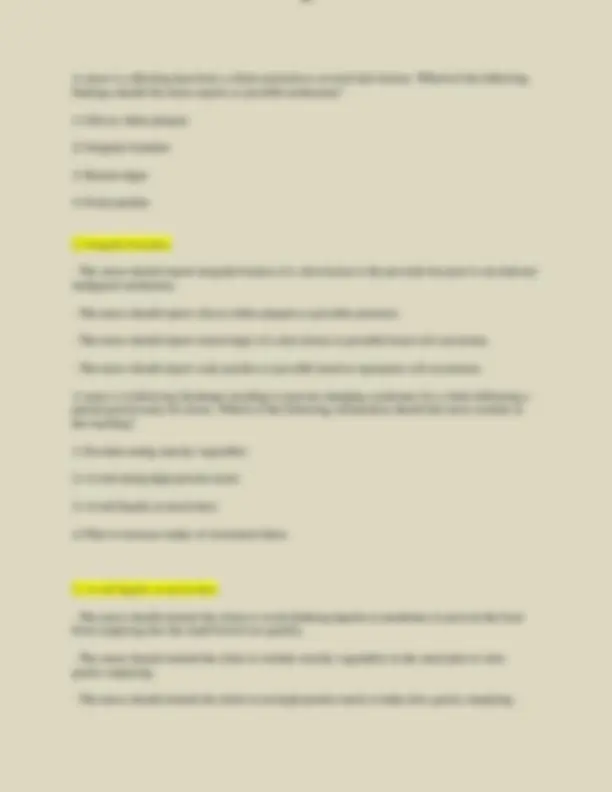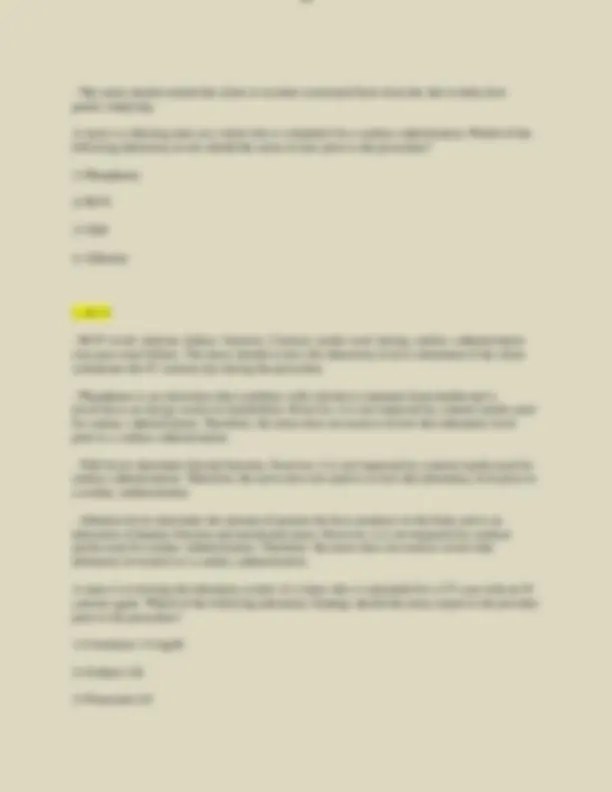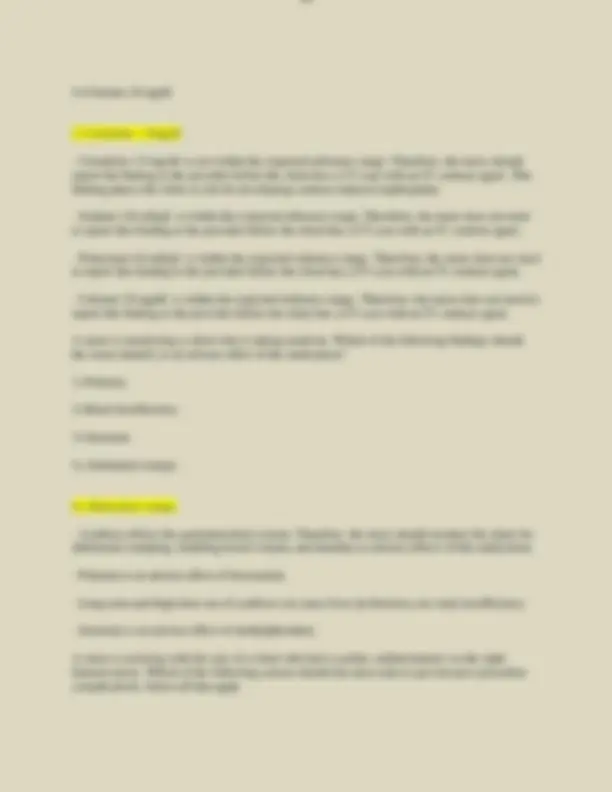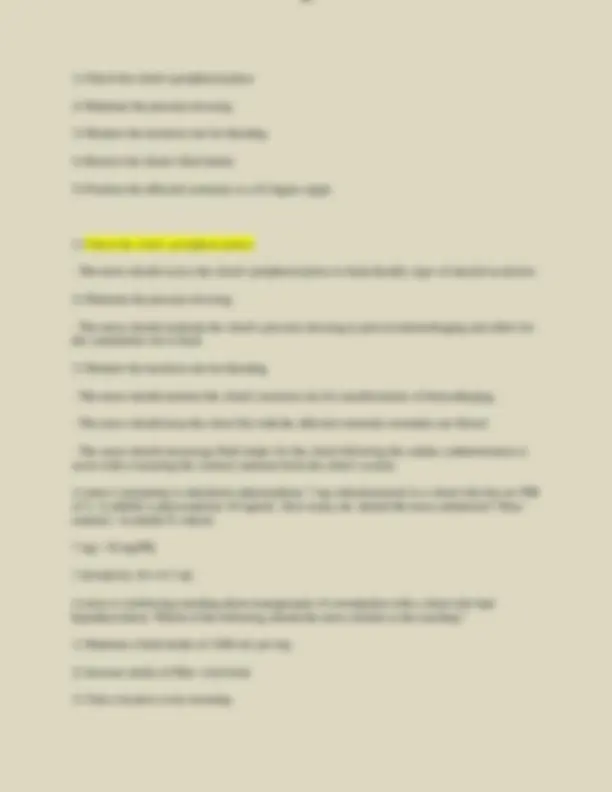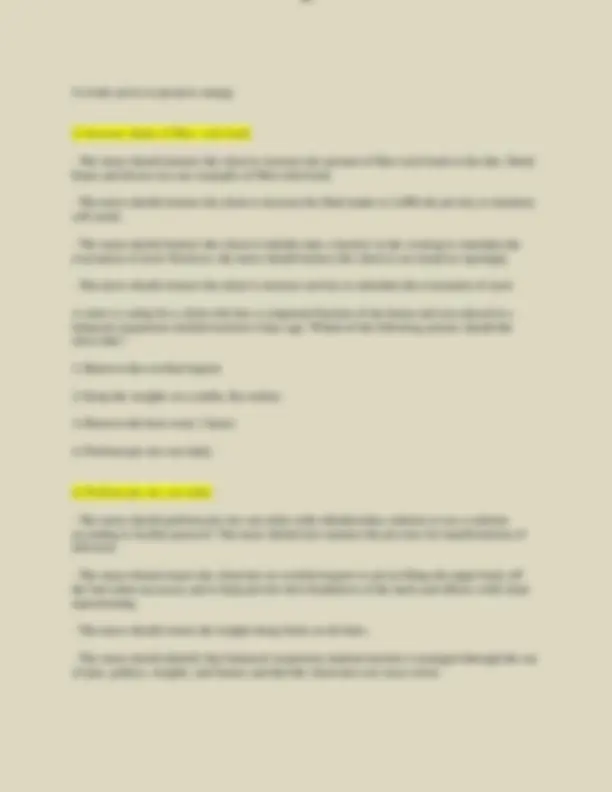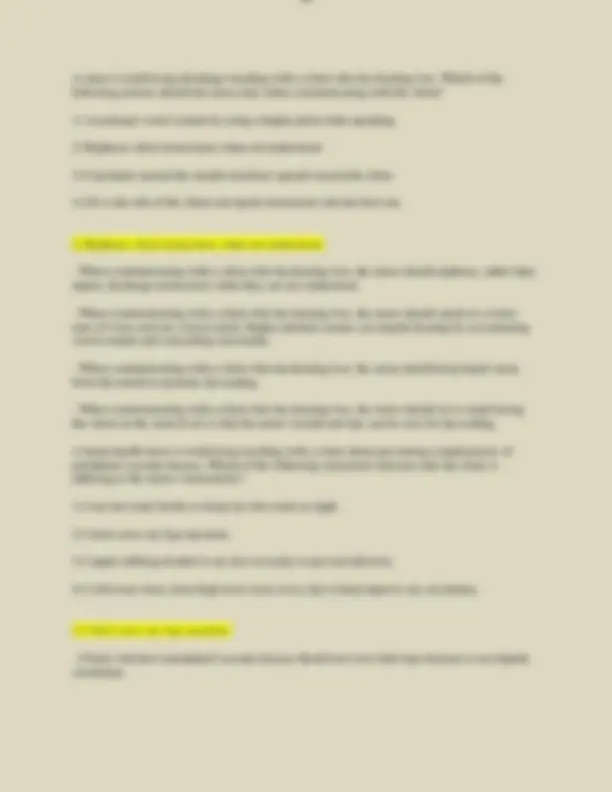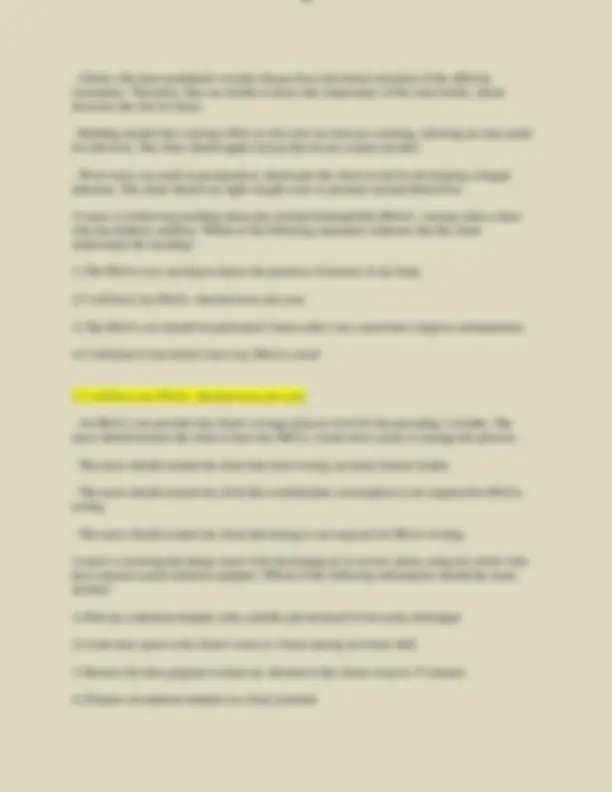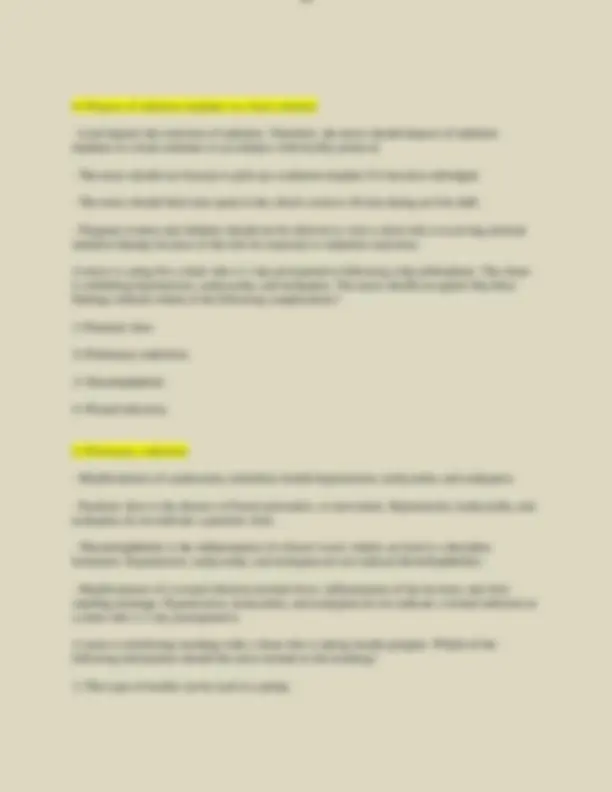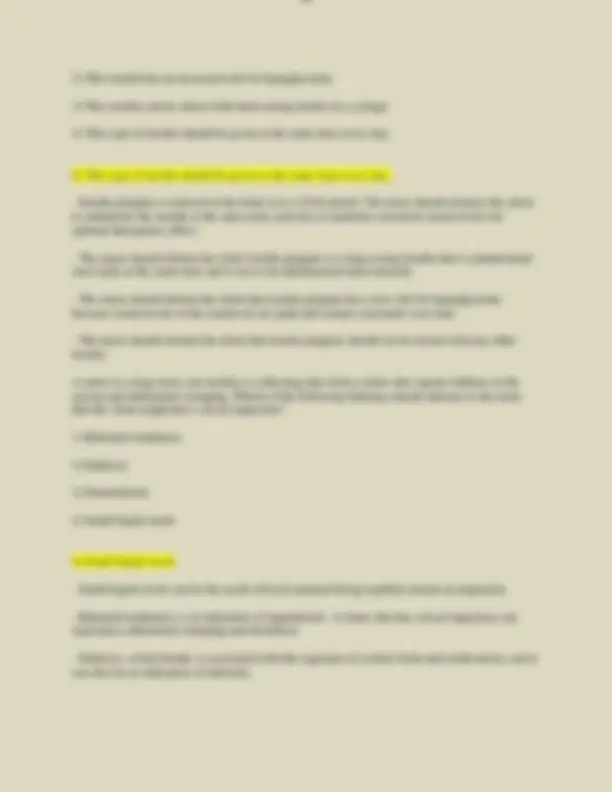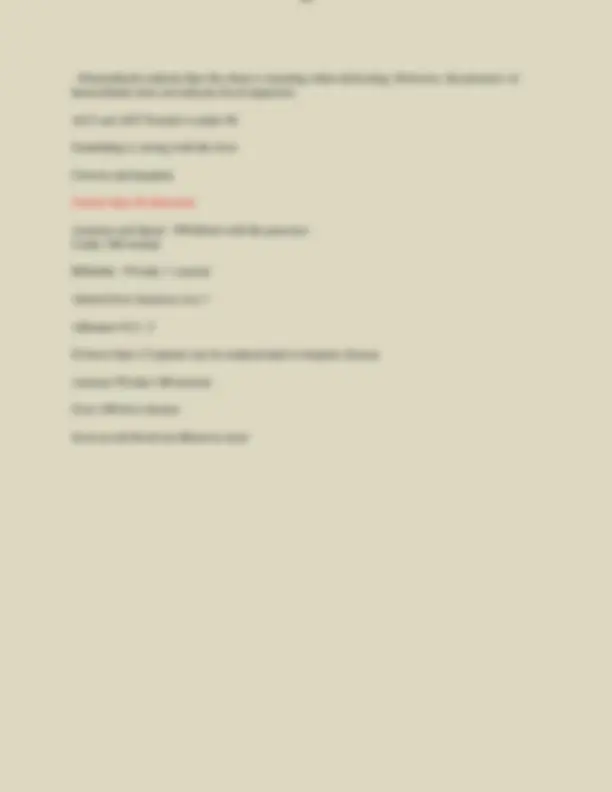Download 2024 ATI MEDICAL SURGICAL PROCTORED EXAM QUESTIONS & CORRECT ANSWERS and more Exams Medical Sciences in PDF only on Docsity!
2024 ATI MEDICAL SURGICAL PROCTORED
EXAM QUESTIONS & CORRECT ANSWERS
What would you do for wound Evisceration (removal of internal organs), Emergency management? Saline cover wound What would you do for an ASTHMA emergency management of a bee sting allergies? Epi Pen Seizures and Epilepsy: Seizure precautions During a seizure:
- Position client on the floor 2)Provide a patent airway
- Turn client to side
- Loosen restrictive clothing
Cancer treatment options: Protective Isolation If WBC drops below 1,000, place the client in a private room and initiate neutropenic precautions.
- Have client remain in his room unless he needs to leave for a diagnostic procedure, in that case transport patient and place a mask on him.
- Protect from possible sources of infection (plants, change water in equipment daily)
- Have client, staff and visitors perform frequent hand hygiene, restrict ill visitors
- Avoid invasive procedures (rectal temps, injections)
- Administer (neupogen, neulasta) to stimulate WBC production Infection control: Appropriate room assignment Standard Precautions:
- applies to all patients
- Hand washing a. alcohol based preferred unless hands visually soiled ( then soap and water )
- Gloves - when touching anything that has the potential to contaminate.
- Masks, eye protection & face shields when care may cause splashing or spraying of body fluids Droplet:
- private room or with someone with same illness
- masks Airborne:
- private room
- masks or respiratory protection devices a. use an N95 respirator for tuberculosis
- Negative pressure airflow
- full face protection if splashing or spraying is possible Contact:
- private room or room with same illness
- gloves & gowns
- disposal of infections dressing materials into a single, nonporous bag without touching the outside of the bag TB: Priority action for a client in the emergency department - Wear an N95 or HEPA respirator
- Place client in negative airflow room and implement airborne precautions
Pulmonary Embolism: Risk factors for DVT - Long term immobility
- Oral contraceptives
- Pregnancy
- Tobacco use
- Hypercoagulabilty
- Obesity
- Surgery
- Heart failure or chronic A-Fib
- Autoimmune hemolytic anemia (sickle cell)
- Long bone fractures
- Advanced age Disorders of the male reproductive system: Complications of continuous irrigation following Trans-urethral Resection
- Urethral trauma
- Urinary retention
- Bleeding
- Infection Non-modifiable risk factors
- Age
- Gender
- Genetics
- Developmental level
Modifiable risk factors
- Smoking
- Exercise
- Health education and awareness
- Nutrition
- Sex practices Emergency nursing - Triage BASED ON ACUITY
- Emergent- Life threatening situation going on.
- Urgent - Need to be treated soon but not life threatening.
- Non urgent- The patient can wait for an extended period of time, without big issues.
Mass Casualty Event
Class 1 - RED TAG - Immediate threat to life Examples:
- Breathing issues
- Chest pain
- Heart attack coming on
- Airway problem Class II - YELLOW TAG - Major injuries that require immediate treatment but not life threatening. Examples:
- Major fracture Class III - GREEN TAG - Minor injury that does not require immediate attention. EXAMPLES:
- Abrasion
- Laceration Class IV - BLACK TAG - Expected to die EXAMPLES:
- Penetrating head wound Triage priority setting
- Red tag
- Yellow Tag
- Green tag
- Black tag
- Increase the temperature of the room
- Warm IV fluid going into the patient IF patient has had accidental or purposeful poisoning:
- Activated charcoal
- Gastric lavage
- Whole bowel irrigation *** DO NOT INDUCE VOMITING OR SYRUP OF IPECAC Call rapid response team when client is rapidly declining. Cardiac Emergencies: If V fib or ventricular tachycardia you would initiate:
- Basic life support ( BLS) and CPR
- Establish IV access
- Epinephrine is used to get the heart up and moving. Alpha 1 receptors Activation Causes the skin, mucus membranes and veins to vasoconstrict. Help with:
- Congestion
- Superficial bleeding
- In general help raise blood pressure by constricting the veins.
DRUG:
Epinephrine: Triggers the Alpha 1 receptors Causing vasoconstriction and increase blood pressure. Epinephrine side effects
- Hypertensive crisis
- Dysrhythmia
- Angina Dopamine side effects
- Dysrhythmia
- Angina Dobutamine side effects Increased heart rate Beta 1 receptors→Help stimulate the heart Beta I - You have 1 heart Stimulate the heart and increase the heart rate Used for treating:
- AV block
- Cardiac arrest DRUG: Epinephrine →Triggers the Beta 1 receptors Cause increase heart rate Beta II receptors →Help stimulate the heart and lungs Beta II You have 2 Lungs Causes:
- Bronchodilation in the lungs
- Causes uterine smooth muscle to relax
- Asthma situation DRUG: Epinephrine → Triggers the Beta II receptors Cause bronchodilation and treat Asthma
- Combination oral contraceptives
- The nurse should identify that combination oral contraceptives are contraindicated for this client because they increase estrogen levels, which can stimulate the growth of any remaining cancerous breast cells.
- The nurse should identify that the use of an intrauterine device requires the client to check the placement monthly and is not contraindicated for this client.
- The nurse should identify that the use of latex condoms is contraindicated for clients, or their partners, who are allergic to latex. However, it is not contraindicated for this client.
- The nurse should identify that prolonged use of a contraceptive sponge can increase the risk for toxic shock syndrome. However, it is not contraindicated for this client. A nurse is collecting data from a client who has heart failure and is on digoxin. Which of the following outcomes from the medication should the nurse expect?
- Increased heart rate
- Decreased urinary output
- Decreased shortness of breath
- Increased weight
- Decreased shortness of breath
- The nurse should expect the client to have decreased shortness of breath. Digoxin increases the contractility of the heart, which decreases pulmonary congestion.
- The nurse should expect the client's heart rate to decrease because digoxin decreases the client's sympathetic nerve tone, which slows the heart rate.
- The nurse should expect the client to have an increase in urinary output because digoxin improves cardiac output and increases the client's renal blood flow through the kidneys, which results in an increased excretion of urine.
- The nurse should expect the client's weight to decrease because of the increased excretion of fluid that is caused by improved cardiac output.
A nurse is reinforcing teaching with a client who has Systemic Lupus Erthematosus (SLE) and is to begin taking mythylprednisolone orally. Which of the following statements should the nurse include in the teaching?
- Limit contact with large groups of people.
- Take medication on a empty stomach
- Follow a low- protein diet
- Avoid taking over the counter calcium supplements
- Limit contact with large groups of people.
- Glucocorticoids cause immunosuppression and may mask infection. The client should limit contact with sources of possible infections, such as large groups of people.
- The client should take glucocorticoids with food to prevent gastrointestinal upset and bleeding.
- It is not necessary for a client who has SLE and is taking a glucocorticoid to restrict protein intake.
- Clients who take glucocorticoids are at risk for osteoporosis, so they should take additional vitamin D and calcium supplements. A nurse is caring for a client who is 24 hours postoperative following abdominal surgery and has an NG tube. Which of the following actions should the nurse plan to take to decrease the risk of postoperative complications?
- Place one or two pillows beneath the clients knee's while he is in bed.
- Offer sips of water to the client following oral care.
- Massage the clients lower extremities with lotion every 2 hours.
- Encourage the client to use an incentive spirometer every hour while awake.
- Encourage the client to use an incentive spirometer every hour while awake.
- The nurse should assist the client to use the incentive spirometer in addition to coughing and deep breathing every hour while awake for the first 24 hr postoperatively and at least every 2 hr while awake thereafter. An incentive spirometer will inflate the client's alveoli and improve ventilation to prevent postoperative pneumonia.
A nurse is reinforcing teaching with a client who has Multiple Sclerosis and a new prescription for baclofen. Which of the following instructions should the nurse include in the teaching?
- Take this medication on an empty stomach
- Avoid stopping this medication suddenly.
- Use Chamomile tea to alleviate insomnia.
- Consume a low- purine diet
- Avoid stopping this medication suddenly.
- The nurse should instruct the client to avoid stopping baclofen suddenly because it can result in adverse reactions, including seizures, paranoia, and hallucinations.
- The nurse should instruct the client to take baclofen with milk or food to minimize gastric upset.
- The nurse should instruct the client to avoid chamomile because it can interact with baclofen to increase CNS depression.
- The nurse should recommend a low-purine diet for a client who has gout and a prescription for colchicine. A nurse is reviewing the laboratory results of a client who has type II diabetes mellitus. The nurse should identify that which of the following laboratory values indicates the client is at risk for delayed wound healing?
- Prealbumin 12mg/dl
- HBA1c 6%
- WBC 8,000/mm
- Creatinine 0.8 mg/dl
- Prealbumin 12mg/dl
- This laboratory value is below the expected reference range, indicating that the client's protein status is inadequate and that he is at risk for delayed wound healing due to malnutrition.
- This laboratory value indicates glycemic control and does not indicate that the client is at risk for delayed wound healing. The nurse should identify that elevated HbA1c levels can increase the risk for delayed wound healing.
pH 7.35-7. HbA1c (glycosylated hemoglobin) <6% *>6.5% indicated DM BUN 10 - 20 mg/dL
Dehydration <<<< Fluid overload Creatinine 0.6 - 1. A nurse is assisting with discharge planning for a client who is postoperative following a total hip arthroplasty. Which of the following instructions should the nurse include in the discharge plan?
- Avoid lying on the operative side.
- Expect decreased sensation for the first postoperative week.
- Cross legs at the ankles
- Obtain a raised toilet seat
- Obtain a raised toilet seat
- The nurse should instruct the client to use a raised toilet seat to avoid flexing the hip more than 90°, which increases the risk for dislocation.
- The nurse should instruct the client that lying on the operative side is allowed but the client should place pillows between the legs to prevent dislocation of the hip.
- The nurse should instruct the client to report decreased sensation in the affected foot or leg because this can indicate neurovascular compromise.
- The nurse should instruct the client to avoid crossing her legs to prevent dislocation of the hip.
A nurse is preparing to remove a client's NG tube. Which of the following interventions should the nurse take to decrease the risk of aspiration.
- Instill 10ml of air through the NG tube
- Place the client in a supine position.
- Irrigate the NG tube
- Pinch the NG tube
- Pinch the NG tube
- The nurse should pinch the NG tube to prevent secretions from draining into the client's throat, which can cause aspiration.
- The nurse should instill 50 mL of air through the NG tube to remove mucus and gastric secretions from the tube and to prevent aspiration of these secretions.
- The nurse should place the client in a sitting position to prevent the risk of aspiration.
- The nurse should identify that irrigating the NG tube before removal can put the client at risk for aspiration and should be avoided. A nurse is collecting data from a client who has chronic kidney disease with hyperkalemia. Which of the following findings should the nurse expect related to hyperkalcemia?
- Anorexia
- Bradycardia
- Constipation
- Polyuria
- Bradycardia
- The client who has hyperkalemia can have an irregular, slow heart rate, known as bradycardia.
- Anorexia is a manifestation of hypokalemia.
- Constipation is a manifestation of hypokalemia.
- Polyuria is a manifestation of hypokalemia.
A nurse is caring for a client and administers penicillin IM. The client begins exhibiting hives and has severe difficulty breathing. After establishing a patent airway, which of the following actions should the nurse take next?
- Monitor the client's vital signs
- Administer epinephrine
- Administer an antihistamine
- Monitor the client's oxygen saturation level.
- Administer epinephrine
- The greatest risk to the client is death from anaphylaxis. Therefore, the nurse should administer epinephrine to reduce bronchospasms and laryngeal edema.
- The nurse should monitor the client's vital signs during the crisis to detect a decrease in blood pressure and an increase in respiratory effort. However, there is another action the nurse should take first.
- The nurse should administer an antihistamine to treat the hives and reduce the histamine release. However, there is another action the nurse should take first.
- The nurse should monitor the client's oxygen saturation level to ensure respiratory support. However, there is another action the nurse should take first. A nurse is reinforcing teaching with a client who has mitral valve disease. Which of the following statements by the client indicates an understanding of the disease process?
- I may develop excessive bruising
- I should call my doctor if I get a headache
- I may develop gastric reflux
- I should call my doctor if my ankles swell.
- I should call my doctor if my ankles swell. Swelling of the ankles can indicate heart failure. The client should report this finding to the provider.
- A provider may prescribe anticoagulants to prevent thrombus formation on the valve, which can cause excessive bruising for a client who has mitral valve disease. However, excessive bruising is not a direct result of the disease.
- Headaches are not a complication of mitral valve disease.
- Mitral valve disease does not cause gastric reflux. A nurse is monitoring an older adult client who has a history of enlarged prostate and is experiencing suprapubic discomfort. Which of the following actions should the nurse take first?
- Administer doxazosin
- Palpate the abdomen
- Insert an indwelling urinary catheter
- Notify the primary care provider.
- Palpate the abdomen When providing client care, the nurse should first use the least restrictive intervention. Therefore, the nurse should palpate the abdomen to determine if the client has a distended bladder from urinary retention.
- The nurse may need to administer doxazosin to relax the smooth muscle of the bladder to increase urine flow. However, the nurse should use a less restrictive intervention first.
- The nurse may need to insert an indwelling urinary catheter for a distended bladder. However, the nurse should use a less restrictive intervention first.
- The nurse may need to notify the primary care provider if the client has a distended bladder. However, the nurse should use a less restrictive intervention first. A nurse is contributing to the plan of care for a client who has chronic obstructive pulmonary disease ( COPD) and is dyspneic. Which of the following interventions should the nurse include in the plan?
- Direct the client to inhale with pursed lips
- Instruct the client to lean back when coughing
- Set the oxygen level at 5 L/min
- Encourage abdominal breathing.

